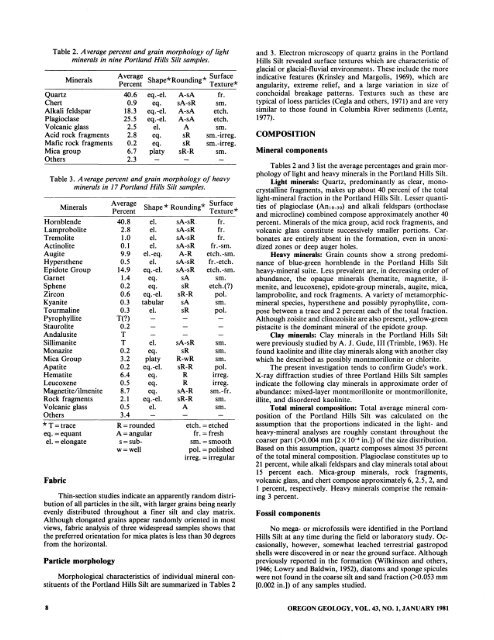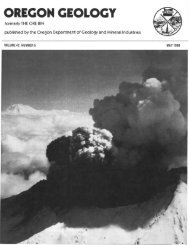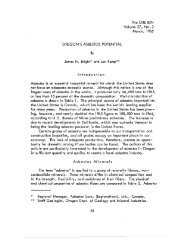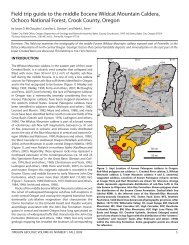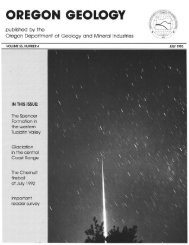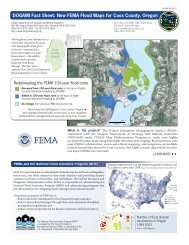The petrology and stratigraphy of the Portland Hills Silt - Oregon ...
The petrology and stratigraphy of the Portland Hills Silt - Oregon ...
The petrology and stratigraphy of the Portland Hills Silt - Oregon ...
You also want an ePaper? Increase the reach of your titles
YUMPU automatically turns print PDFs into web optimized ePapers that Google loves.
Table 2. A verage percent <strong>and</strong> grain morphology oj light<br />
minerals in nine Portl<strong>and</strong> <strong>Hills</strong> <strong>Silt</strong> samples.<br />
Minerals<br />
Average . Surface<br />
Percent Shape*Roundmg* Texture*<br />
Quartz 40.6 eq.-el. A-sA fro<br />
Chert 0.9 eq. sA-sR sm.<br />
Alkali feldspar 18.3 eq.-el. A-sA etch.<br />
Plagioclase 25.5 eq.-el. A-sA etch.<br />
Volcanic glass 2.5 el. A sm.<br />
Acid rock fragments 2.8 eq. sR sm.-irreg.<br />
Mafic rock fragments 0.2 eq. sR sm.-irreg.<br />
Mica group 6.7 platy sR-R sm.<br />
O<strong>the</strong>rs 2.3<br />
Table 3. A verage percent <strong>and</strong> grain morphology oj heavy<br />
minerals in 17 Portl<strong>and</strong> <strong>Hills</strong> <strong>Silt</strong> samples.<br />
Minerals<br />
Average<br />
Shape * Rounding* Surface<br />
Percent Texture *<br />
Hornblende 40.8 el. sA-sR. fro<br />
Lamprobolite 2.8 el. sA-sR fro<br />
Tremolite 1.0 el. sA-sR fro<br />
Actinolite 0.1 el. sA-sR fr.-sm.<br />
Augite 9.9 el.-eq. A-R etch.-sm.<br />
Hypers<strong>the</strong>ne 0.5 el. sA-sR fr.-etch.<br />
Epidote Group 14.9 eq.-el. sA-sR etch.-sm.<br />
Garnet 1.4 eq. sA sm.<br />
Sphene 0.2 eq. sR etch.(?)<br />
Zircon 0.6 eq.-el. sR-R pol.<br />
Kyanite 0.3 tabular sA sm.<br />
Tourmaline 0.3 el. sR pol.<br />
Pyrophyllite T(?)<br />
Staurolite 0.2<br />
Andalusite<br />
T<br />
Sillimanite T el. sA-sR sm.<br />
Monazite 0.2 eq. sR sm.<br />
Mica Group 3.2 platy R-wR sm.<br />
Apatite 0.2 eq.-el. sR-R pol.<br />
Hematite 6.4 eq. R irreg.<br />
Leucoxene 0.5 eq. R irreg.<br />
Magnetite/ilmenite 8.7 eq. sA-R sm.-fr.<br />
Rock fragments 2.1 eq.-el. sR-R sm.<br />
Volcanic glass 0.5 el. A sm.<br />
O<strong>the</strong>rs 3.4<br />
*T=trace R=rounded etch. = etched<br />
eq. = equant A=angular fro = fresh<br />
el. = elongate s=sub- sm. = smooth<br />
w=well<br />
pol. = polished<br />
irreg. = irregular<br />
Fabric<br />
Thincsection studies indicate an apparently r<strong>and</strong>om distribution<br />
<strong>of</strong> all particles in <strong>the</strong> silt, with larger grains being nearly<br />
evenly distributed throughout a finer silt <strong>and</strong> clay matrix.<br />
Although elongated grains appear r<strong>and</strong>omly oriented in most<br />
views, fabric analysis <strong>of</strong> three widespread samples shows that<br />
<strong>the</strong> preferred orientation for mica plates is less than 30 degrees<br />
from <strong>the</strong> horizontal.<br />
Particle morphology<br />
Morphological characteristics <strong>of</strong> individual mineral constituents<br />
<strong>of</strong> <strong>the</strong> Portl<strong>and</strong> <strong>Hills</strong> <strong>Silt</strong> are summarized in Tables 2<br />
<strong>and</strong> 3. Electron microscopy <strong>of</strong> quartz grains in <strong>the</strong> Portl<strong>and</strong><br />
<strong>Hills</strong> <strong>Silt</strong> revealed surface textures which are characteristic <strong>of</strong><br />
glacial or glacial-fluvial environments. <strong>The</strong>se include <strong>the</strong> more<br />
indicative features (Krinsley <strong>and</strong> Margolis, 1969), which are<br />
angularity, extreme relief, <strong>and</strong> a large variation in size <strong>of</strong><br />
conchoidal breakage patterns. Textures such as <strong>the</strong>se are<br />
typical <strong>of</strong> loess particles (Cegla <strong>and</strong> o<strong>the</strong>rs, 1971) <strong>and</strong> are very<br />
similar to those found in Columbia River sediments (Lentz,<br />
1977).<br />
COMPOSITION<br />
Mineral components<br />
Tables 2 <strong>and</strong> 3 list <strong>the</strong> average percentages <strong>and</strong> grain morphology<br />
<strong>of</strong>light <strong>and</strong> heavy minerals in <strong>the</strong> Portl<strong>and</strong> <strong>Hills</strong> <strong>Silt</strong>.<br />
Light minerals: Quartz, predominantly as clear, monocrystalline<br />
fragments, makes up about 40 percent <strong>of</strong> <strong>the</strong> total<br />
light-mineral fraction in <strong>the</strong> Portl<strong>and</strong> <strong>Hills</strong> <strong>Silt</strong>. Lesser quantities<br />
<strong>of</strong> plagioclase (An\o-30) <strong>and</strong> alkali feldspars (orthoclase<br />
<strong>and</strong> microcline) combined compose approximately ano<strong>the</strong>r 40<br />
percent. Minerals <strong>of</strong> <strong>the</strong> mica group, acid rock fragments, <strong>and</strong><br />
volcanic glass constitute successively smaller portions. Carbonates<br />
are entirely absent in <strong>the</strong> formation, even in unoxidized<br />
zones or deep auger holes.<br />
Heavy minerals: Grain counts show a strong predominance<br />
<strong>of</strong> blue-green hornblende in <strong>the</strong> Portl<strong>and</strong> <strong>Hills</strong> <strong>Silt</strong><br />
heavy-mineral suite. Less prevalent are, in decreasing order <strong>of</strong><br />
abundance, <strong>the</strong> opaque minerals (hematite, magnetite, ilmenite,<br />
<strong>and</strong> leucoxene), epidote-group minerals, augite, mica,<br />
lamprobolite, <strong>and</strong> rock fragments. A variety <strong>of</strong> metamorphicmineral<br />
species, hypers<strong>the</strong>ne <strong>and</strong> possibly pyrophyllite, compose<br />
between a trace <strong>and</strong> 2 percent each <strong>of</strong> <strong>the</strong> total fraction.<br />
Although zoisite <strong>and</strong> clinozoisite are also present, yellow-green<br />
pistacite is <strong>the</strong> dominant mineral <strong>of</strong> <strong>the</strong> epidote group.<br />
Clay minerals: Clay minerals in <strong>the</strong> Portl<strong>and</strong> <strong>Hills</strong> <strong>Silt</strong><br />
were previously studied by A. J. Gude, III (Trimble, 1963). He<br />
found kaolinite <strong>and</strong> illite clay minerals along with ano<strong>the</strong>r clay<br />
which he described as possibly montmorillonite or chlorite.<br />
<strong>The</strong> present investigation tends to confirm Gude's work.<br />
X-ray diffraction studies <strong>of</strong> three Portl<strong>and</strong> <strong>Hills</strong> <strong>Silt</strong> samples<br />
indicate <strong>the</strong> following clay minerals in approximate order <strong>of</strong><br />
abundance: mixed-layer montmorillonite or montmorillonite,<br />
illite, <strong>and</strong> disordered kaolinite.<br />
Total mineral composition: Total average mineral composition<br />
<strong>of</strong> <strong>the</strong> Portl<strong>and</strong> <strong>Hills</strong> <strong>Silt</strong> was calculated on <strong>the</strong><br />
assumption that <strong>the</strong> proportions indicated in <strong>the</strong> light- <strong>and</strong><br />
heavy-mineral analyses are roughly constant throughout <strong>the</strong><br />
coarser part (>0.004 mm [2 x 10-4 in.]) <strong>of</strong> <strong>the</strong> size distribution.<br />
Based on this assumption, quartz composes almost 35 percent<br />
<strong>of</strong> <strong>the</strong> total mineral composition. Plagioclase constitutes up to<br />
21 percent, while alkali feldspars <strong>and</strong> clay minerals total about<br />
15 percent each. Mica-group minerals, rock fragments,<br />
volcanic glass, <strong>and</strong> chert compose approximately 6, 2.5, 2, <strong>and</strong><br />
1 percent, respectively. Heavy minerals comprise <strong>the</strong> remaining<br />
3 percent.<br />
Fossil components<br />
No mega- or micr<strong>of</strong>ossils were identified in <strong>the</strong> Portl<strong>and</strong><br />
<strong>Hills</strong> <strong>Silt</strong> at any time during <strong>the</strong> field or laboratory study. Occasionally,<br />
however, somewhat leached terrestrial gastropod<br />
shells were discovered in or near <strong>the</strong> ground surface. Although<br />
previously reported in <strong>the</strong> formation (Wilkinson <strong>and</strong> o<strong>the</strong>rs,<br />
1946; Lowry <strong>and</strong> Baldwin, 1952), diatoms <strong>and</strong> sponge spicules<br />
were not found in <strong>the</strong> coarse silt <strong>and</strong> s<strong>and</strong> fraction (>0.053 mm<br />
[0.002 in.]) <strong>of</strong> any samples studied.<br />
8<br />
OREGON GEOLOGY, VOL. 43, NO. I, JANUARY 1981


